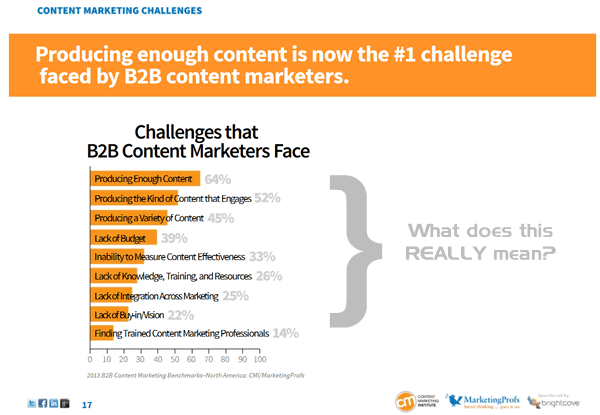 Most content marketing strategies and plans fail if there is no buy-in and real engagement across the different levels of the organization. That’s a huge challenge. Any solid content marketing strategy involves several departments and that’s where the troubles often start. When was the last time your marketing team ever engaged everyone in the company? The answer is probably ‘never’ or ‘I don’t remember’.
Most content marketing strategies and plans fail if there is no buy-in and real engagement across the different levels of the organization. That’s a huge challenge. Any solid content marketing strategy involves several departments and that’s where the troubles often start. When was the last time your marketing team ever engaged everyone in the company? The answer is probably ‘never’ or ‘I don’t remember’.
And that’s normal in most businesses. Let’s face it: trust in marketing is not that high, sales is still seen as ‘those making the money’ and management is rarely really interested in what the marketing team is cooking up and looking more at quota and numbers than at customer experiences or relevant content.
The perfect social/connected business is an utopia
However, a full-fledged content marketing strategy requires collaboration and engagement across the enterprise to succeed. Here’s a truth: organizations that don’t have a content- and data-driven culture revolving around the customer experience, consistency and collaboration, lose in the end. A second truth: the fully collaborative and streamlined social business is an utopia. It’s something you want to work on as you know that a customer-centric content strategy and company-wide alignment between brand position, business goals, customer tasks and consistent touchpoints is the way to go.
It’s OK that the fully aligned – let alone, optimized – business is an utopia. Well, it’s typical, at least. And it’s a great opportunity for you to work closer towards it.
So, as a marketer, you face many challenges from the internal perspective. Getting buy-in for your content marketing strategy is the same as getting buy-in for a full-fledged social strategy as it touches all departments as well in a more mature stage. You know who your natural “ally” is.
If you look at all the major challenges faced in content marketing, you’ll notice they can be summarized in one simple underlying cause: the organization is not ‘ready’ and properly structured to deal with a customer-driven reality, to work in a holistic way and to engage stakeholders. You’ll notice the exact same thing when looking at the major challenges in social media marketing, social business, customer experience management, multi-channel marketing, email marketing, etc.
Some examples from Content Marketing research by the Content Marketing Institute to illustrate this point:
- The confidence gap regarding effectiveness of content marketing tactics. There is not a single tactic in content marketing where respondents more or less agree on effectiveness (check presentation below or read here). This can be partially explained because the success of a tactic depends on the context in which it is used. However, it also indicates a lack of a holistic view and that respondents are rarely measuring in a broader context. You can only measure in an integrated way if you have closed the loop and thus have a solid content marketing strategy across divisions and tactics.
- The immature way in which content marketing success is measured. 60% of respondents looks at web traffic as the main indicator of content marketing success, 45% at social media sharing and 39% even at time spent on website. The time people spend on your website is not an indicator of success if you don’t know why they spend that amount of time. This immaturity again shows no company-wide and overall deployment.
- The 5 main challenges B2B content marketers face (from producing enough content and lack of budget to lack of integration across marketing): they all indicate a lack of vision, buy-in and engagement (see screenshot below). By the way: lack of buy-in and vision is cited by 22% or respondents. However, all the other challenges in the end mean the same.

Social business and content marketing strategy: who is responsible?
Is it the task of marketing to convince all internal stakeholders to collaborate and implement necessary change to be more efficient as an organization in a digital age? Is it the task of the CIO? Sales? The CEO? The Chief Customer Officer if you have one? Who is responsible for getting buy-in and employee/collaborator engagement? It depends and I don’t always know. But here’s what I do know: marketers can make it happen so it’s your opportunity and, in that sense, task. And: you’ll need to work with most people I mentioned sooner or later. The CIO and IT staff, for instance, will certainly come in the picture when you’re looking at selecting/implementing content marketing software or marketing software with a content marketing/management component.
The CEO will have to give the green light for changes and approving budgets, along with the CFO. And sales will have to be on board… In some business with very traditional sales models, sales will often prove to be the hardest one to convince until you help them…selling (or closing the buy) and show that with a good content marketing strategy you actually complement their traditional models. If you measure the impact of your content marketing strategy very well across touchpoints, you even might end up having the hard data proving that the traditional model is far less effective…
In practice I notice most initiatives regarding content marketing strategy and plans nowadays come from the social team and – increasingly – the digital and search team. Although you also see initiatives coming from the C-suite (and that’s an advantage). Why not take the initiative and the responsibility along with it yourself?
Take the lead with your customer-centric and collaborator-oriented content marketing strategy
So, you know what you want to achieve. That perfectly collaborative and customer-centric utopia, supported by a solid content marketing strategy across the organization and with good buy-in. You know that as a marketer you can make the difference and even take the lead. However, how do you get started? And in the scope of this blog post: how do you get buy-in, engagement and involvement to define and roll out a customer-centric (B2B) content marketing strategy? How do you bypass internal turf wars and conservative egos, protecting silos that contain the content you need to make your content marketing strategy happen? How do you convince other team members to be the eyes, ears and voices of your business in a social and content-intensive space? How do you convince the C-suite and heads of departments?
Well, on top of knowing how to calculate and prove ROI of your marketing plans (which goes for a content marketing strategy plan too), you’ll have to apply the same techniques and ask the same questions as a good content marketing expert does: focus on the what do THEY want question and go for buyer-centric, customer-centric, experience-centric, people-centric etc. content marketing, the Copernican way (you are not the center of your customer’s attention and don’t get buy-in if you don’t take into account what your teams and managers want – they are your customers too).
Without looking at the individual and business goals of your internal teams – and even their bonus systems – it’s hard to get buy-in for any marketing initiative that needs a cross-divisional collaboration and culture. Content marketing requires such a culture so look at how you can use content marketing to help the people YOU need internally achieve THEIR goals.
Buy-in for content marketing needs to happen at all levels. And often the best way to get it, is not talking about content marketing at all as most of your different managers are not interested in that but in how they can get better results. Even if the C-suite buy-in is there, you still have to get all the others on board. So, focus on their goals. Make sure you know the main stumbling blocks of your internal stakeholders to succeed in their job and include them when starting working on a content marketing strategy. Ideally, involve the stakeholders in the development of your content marketing strategy. I know, that’s not always easy to do so if you have buy-in from a few key stakeholders (management, for instance) it should make life easier.
Before ‘building’ your content marketing strategy or – if that’s impossible – once you decided to fully deploy a content marketing initiative (maybe after some pilots and supported with solid data) conduct some calls and meetings with team managers whereby you ask them what their priorities are, what difficulties they have and how they perceive the impact of a changed – connected and “pull” – market reality. Based on that, you can suggest ways an integrated content marketing strategy can help, again in a calculated way and after having aggregated all answers and looked at them with your team and management.
Finally, don’t only look at their “work and results” goals: people don’t only want to succeed in their job, there are many emotional elements as well.
Questions to ask internal stakeholders in a preparatory content marketing strategy stage
The questions to be asked for your content marketing strategy to succeed really don’t differ that much from those you will ask when, for instance, getting internal buy-in or collaboration for, let’s say, social media marketing. The difference is more in the way you ask them and the suggestions you can already include. Obviously, it’s important that you and your team have looked at the different ways content marketing can improve different challenges. You know your company, internal issues and challenges better than anyone else.
Also note that – although the term content marketing indicates it’s about marketing – a content ‘business’ strategy can encompass other business functions. Content is also crucial for sales, customer service and many other business functions.
In part 2 of this series I’ll look at some questions you can ask – depending on your context – and what to look at in getting buy-in for your customer-centric content marketing strategy.
In the meantime, take a look at your internal organization, identify where the pain points are, analyze how you can make the case for necessary changes and look where the content you need to have a consistent content marketing strategy sits.
Keep in mind these 6 questions if you want to take the ‘content marketing strategy’ and even broader business culture lead:
- What does the customer – in the broad sense – want you and your teams to know and what is holding your organization back from knowing it and acting accordingly?
- What are your internal teams, management and all potential collaborators struggling with, what do they want help with and how can you get them on board by focusing on their goals and including those in your content marketing strategy?
- What emotional and relational stumbling blocks exist in the organization that could block engagement internally, even if you know all the ‘rational’ goals of people?
- What data, resources, timeframes and processes do you need to go from A to Z, knowing that it will nearly always take time and have to happen in a staged approach with Z maybe even being an utopia? Or in other words: how can you take the lead by starting with the right internal content marketing expert team and good external partners and getting others on board when they see the impact. On that note: in many businesses the ones taking the lead get sabotaged. Deal with it and focus on the success of the “others” first.
- What are the benefits of a good content marketing strategy for the business and stakeholders BEYOND the usual benefits that you can use to convince others? You might be surprised how many there are. Think psychology and also impact of company-wide initiatives regarding overall optimization, ROI, etc.
- What does the CxO and any internal stakeholder want you to know and how do you speak their language?
Images purchased under license from Shutterstock






